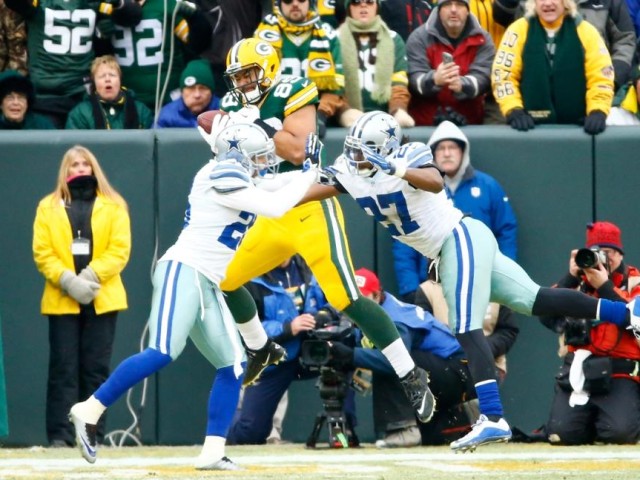
On Sunday against the Dallas Cowboys Aaron Rodgers threw what turned out to be the game winning touchdown for the Green Bay Packers to Richard Rodgers on a play that will go down as one of Aaron’s best throws to date.
The play everyone is talking about was an inside post route by tight end Richard Rodgers that saw him go from right to left across the field to catch the touchdown right on the “G” of “Green Bay” in the end zone. The play can be seen in the GIF below.
It’s hard to make out in that GIF just how impressive of a throw that was, but I think the view from the end zone in the GIF below does a nice job of showing the throwing window that Aaron Rodgers fit the ball in to.
That window was tiny and just a little bit to the left or to the right and that ball is tipped or picked and the Packers likely lose the game. With the help of some measurement software and making use of markers on the field, I want to take a look at and measure just how tight that window was and what went into that play working.
There are three main players/components to this play: Aaron Rodgers and the throw, Richard Rodgers and his defender J.J. Wilcox, and the help defender Sterling Moore.
Looking at Aaron Rodgers on the throw you see Rodgers step out, moving to his left, and as he sets his feet and he releases the ball he is falling to his left. The throw ends up traveling 26.4 yards through the air at a velocity of 48 miles per hour and takes just over a second to leave Aaron Rodgers’ hand and get to Richard Rodgers.
One of the other major components of the play is Richard Rodgers and his defender running across the end zone. They are moving at roughly the same speed and from the moment Richard Rodgers sees Aaron Rodgers escape the pocket until the catch is made you see Richard Rodgers and J.J. Wilcox running at an average velocity of 15 miles per hour across the back half of the end zone.
The final of the three components of the play is Sterling Moore coming from the left side of the end zone to defend the play and because he didn’t get the running start that Rodgers and Wilcox got, he is moving with a much slower average velocity of 8 miles per hour.
With all of those components combined, you start to get an idea of what was happening to the throwing window that Rodgers was looking at.
Aaron Rodgers had mentioned that the window looked a lot bigger when he first threw the ball. Lets take a look at what the window between Moore and Wilcox looked like once Rodgers got out of the pocket and looked up and what it looked like as he threw the ball and it found its way into the hands of Richard Rodgers:
As you can see, the window does look like he should be able to fit the ball in there initially. However Rodgers was falling away from the throw and not really being able to step into it likely made the ball a little slower than he would have liked. That window closed on him in a hurry.
All of this culminates into one throw that fits into a tiny throwing window. The size of that window ends up being an incredible 4 feet high by 3 feet wide.
Sterling Moore is 24 inches away from getting to that ball, which means he is less than a quarter of a second away from tipping it. That is close. However J.J. Wilcox is even closer and comes within a foot of deflecting the ball. Meaning if that ball is thrown 0.04 seconds later, Wilcox gets a finger on it. 12 inches to the right or 24 inches to the left or a release of 0.04 seconds later on a ball that was thrown over 26 yards in the air and the Packers could have had their season ended. That is one hell of a throw.
To put this another way, Rodgers escaped the pocket and looked up for a little over a second before he decided to throw the ball. If he was on a basketball court this throw would be coming from 3 feet behind the free throw line and thrown all the way to the other side of the court to hit a 4 foot high by 3 foot wide target that was six feet in the air and moving at a speed that would cover the entire width of the basketball court in just over two seconds.
He did all of this while falling to his left on a bad calf to provide the game winning score in a playoff game. He’s pretty ridiculous.
——————Mike Reuter lives in the Twin Cities and is a graduate of the University of St. Thomas. He is a mobile tech enthusiast, a 19 year Gopher Football season ticket holder and a huge Packers fan. Mike is a writer with AllGreenBayPackers.com and you can follow him on twitter at @uofmike.
——————

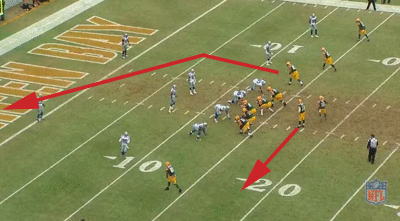
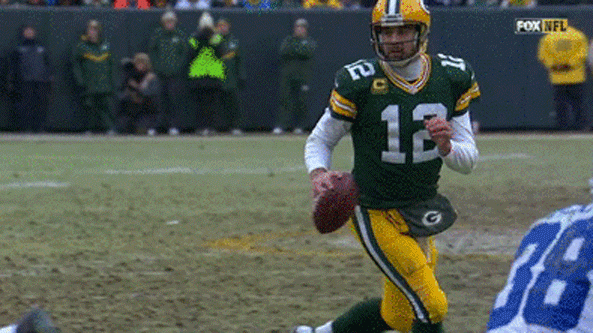

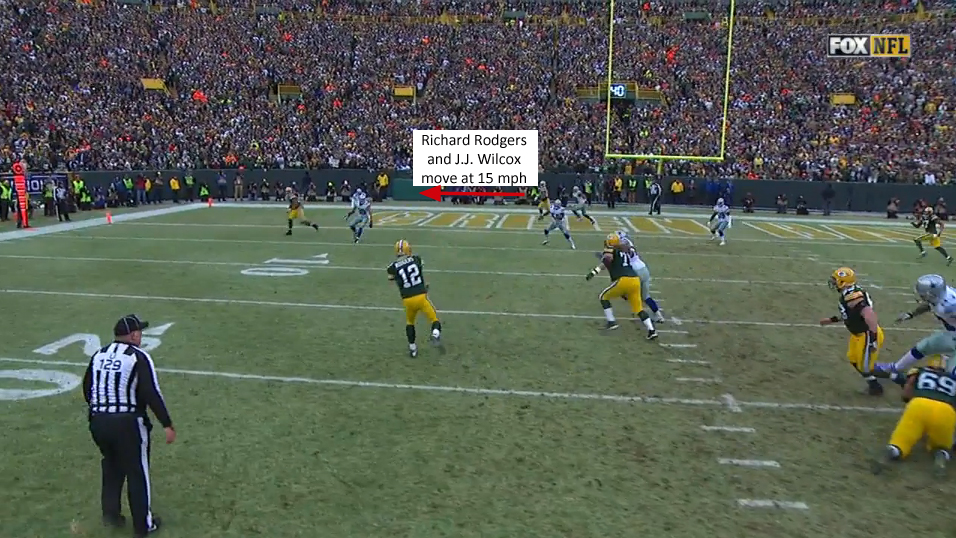
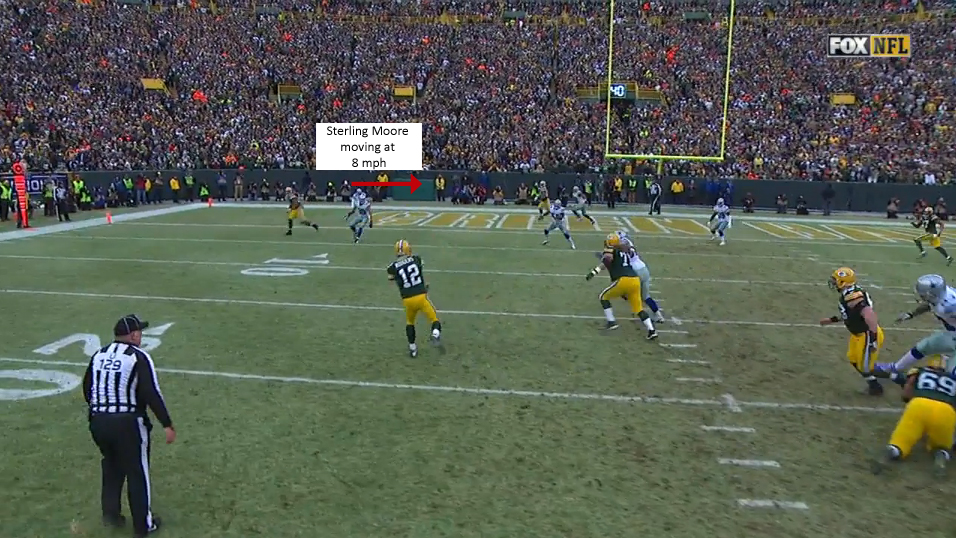
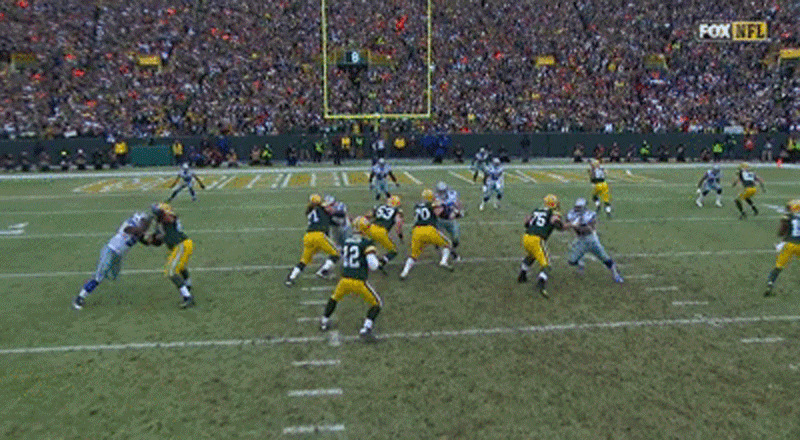

Amazing analysis! Thank you, Mike.
I said it before – it is remarkable how fast the window closes at this level. Rodgers will have less time this week against better coverage. Should be a great matchup. Thanks for the insight.
Another fine piece of the art on allgbp.com. Bravo!
I could geek out on stuff like this all day – great job Mike!
This was a cool analysis. I remember that when I saw the throw on tv in realtime I thought rodgers threw an interception. It wasn’t until I saw Richard Rodgers with the ball that I realized it was a te. Now I know how tight that window was. Amazing.
Cant teach that!
Remarkable! That play is the definition of the perfect pass. I note that Rodgers also had D. Adams open across the middle on the play but that would have been a more difficult throw since A. Rodgers was running away from Adams. Another great play by Rodgers during crunch time. Go Pack Go! Thanks, Since ’61
He also had Quarless to the left for a first down but no guaranteed TD
A smashing analysis Mike!!